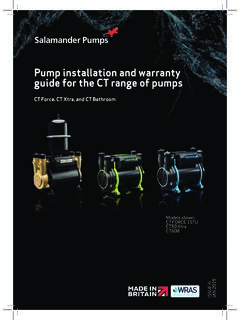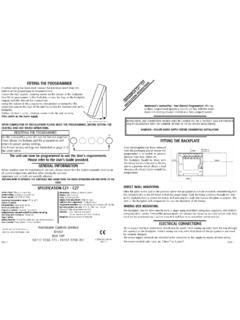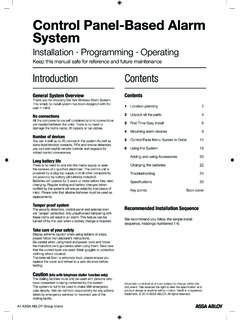Transcription of SAFETY DATA SHEET NO NONSENSE EXPANDING …
1 REVISION DATE: 21-04-2006. SAFETY data SHEET . NO NONSENSE EXPANDING foam . 1 IDENTIFICATION OF THE SUBSTANCE/PREPARATION AND COMPANY/UNDERTAKING. PRODUCT NAME NO NONSENSE EXPANDING foam . APPLICATION Polyurethane foam filler. SUPPLIER Henkel Consumer Adhesives Road 5, Winsford Industrial Estate Winsford Cheshire CW7 3QY. T: 01606 593933. F: 01606 863762. E: 2 COMPOSITION/INFORMATION ON INGREDIENTS. Name EC No. CAS-No. Content Classification DIMETHYL ETHER 204-065-8 115-10-6 10-30% F+;R12. DIPHENYLMETHANE-4,4'-DI-ISOCYANATE 202-966-0 101-68-8 10-30% Xn;R20 R42/43 Xi;R36/37/38. The Full Text for all R-Phrases are Displayed in Section 16. COMPOSITION COMMENTS. Polyurethane foam filler 3 HAZARDS IDENTIFICATION. Extremely flammable.
2 Harmful by inhalation. Irritating to eyes, respiratory system and skin. May cause sensitisation by inhalation and skin contact. CLASSIFICATION Xn;R20. R42/43. Xi;R36/37/38. F+;R12. 4 FIRST-AID MEASURES. GENERAL INFORMATION. Remove affected person from source of contamination. Remove contaminated clothing immediately. Dispose of clothes safely. INHALATION. Move the exposed person to fresh air at once. Keep the affected person warm and at rest. Get prompt medical attention. INGESTION. Not relevant. SKIN CONTACT. Wash the skin immediately with soap and water. Get medical attention if any discomfort continues. EYE CONTACT. Remove victim immediately from source of exposure. Make sure to remove any contact lenses from the eyes before rinsing.
3 Promptly wash eyes with plenty of water while lifting the eye lids. Continue to rinse for at least 15 minutes. Get medical attention if any discomfort continues. 5 FIRE-FIGHTING MEASURES. EXTINGUISHING MEDIA. Use: Powder. Carbon dioxide (CO2). foam . Water spray. DO NOT USE full water jet SPECIAL FIRE FIGHTING PROCEDURES. Containers close to fire should be removed or cooled with water. Use water to keep fire exposed containers cool and disperse vapours. Beware, risk of formation of toxic and corrosive gases. Hydrogen cyanide (HCN), Hydrogen chloride (HCl), Nitrogen oxides (NOx) Use self contained breathing apparatus. UNUSUAL FIRE & EXPLOSION HAZARDS. Aerosol cans may explode in a fire. 1/ 4. REVISION DATE: 21-04-2006. NO NONSENSE EXPANDING foam .
4 6 ACCIDENTAL RELEASE MEASURES. SPILL CLEAN UP METHODS. Wear necessary protective equipment. Extinguish all ignition sources. Avoid sparks, flames, heat and smoking. Ventilate. Allow to cure, and remove mechanically. 7 HANDLING AND STORAGE. USAGE PRECAUTIONS. Keep away from heat, sparks and open flame. Avoid spilling, skin and eye contact. Ventilate well, avoid breathing vapours. Use approved respirator if air contamination is above accepted level. STORAGE PRECAUTIONS. Aerosol cans: Must not be exposed to direct sunlight or temperatures above 50 C. Flammable/combustible - Keep away from oxidisers, heat and flames. Keep upright. Store in a well ventilated, cool and dry place. 8 EXPOSURE CONTROLS/PERSONAL PROTECTION. Name Std LT - ppm LT - mg/m3 ST - ppm ST - mg/m3.
5 DIMETHYL ETHER WEL 400 ppm 766 mg/m3 500 ppm 958 mg/m3. DIPHENYLMETHANE-4,4'-DI-ISOCYANATE WEL mg/m3(Sen) mg/m3(Sen). INGREDIENT COMMENTS. WEL = Workplace Exposure Limits PROTECTIVE EQUIPMENT. ENGINEERING MEASURES. All handling to take place in well-ventilated area. Must not be handled in confined space without sufficient ventilation. RESPIRATORY EQUIPMENT. No specific recommendation made, but respiratory protection must be used if the general level exceeds the Recommended Workplace Exposure Limit. HAND PROTECTION. Use protective gloves. EYE PROTECTION. Use eye protection. OTHER PROTECTION. Wear appropriate clothing to prevent any possibility of liquid contact and repeated or prolonged vapour contact. HYGIENE MEASURES. DO NOT SMOKE IN WORK AREA!
6 Wash at the end of each work shift and before eating, smoking and using the toilet. Promptly remove any clothing that becomes contaminated. When using do not eat, drink or smoke. Wash promptly with soap & water if skin becomes contaminated. Use appropriate skin cream to prevent drying of skin. 9 PHYSICAL AND CHEMICAL PROPERTIES. APPEARANCE Aerosol Liquid COLOUR Cream ODOUR Characteristic RELATIVE DENSITY pH-VALUE, CONC. SOLUTION Not applicable VISCOSITY Not applicable FLASH POINT ( C) < - 20. 10 STABILITY AND REACTIVITY. STABILITY. Stable under normal temperature conditions. CONDITIONS TO AVOID. Avoid heat, flames and other sources of ignition. Avoid contact with: Strong oxidising agents. 2/ 4. REVISION DATE: 21-04-2006.
7 NO NONSENSE EXPANDING foam . HAZARDOUS DECOMPOSITION PRODUCTS. Fire creates: Vapours/gases/fumes of: Carbon monoxide (CO). Carbon dioxide (CO2). Hydrogen chloride (HCl). Hydrogen cyanide (HCN). Nitrous gases (NOx). 11 TOXICOLOGICAL INFORMATION. INHALATION. May cause sensitisation by inhalation. INGESTION. May cause discomfort if swallowed. SKIN CONTACT. May cause skin irritation/eczema EYE CONTACT. Irritating to eyes. ROUTE OF ENTRY. Inhalation. Skin and/or eye contact. 12 ECOLOGICAL INFORMATION. ECOTOXICITY. Not regarded as dangerous for the environment. Product contains organically bound halogen in accordance with the formulation. 13 DISPOSAL CONSIDERATIONS. DISPOSAL METHODS. Empty containers must not be burned because of explosion hazard.
8 Dispose of waste and residues in accordance with local authority requirements. 14 TRANSPORT INFORMATION. PROPER SHIPPING NAME AEROSOLS, flammable UN NO. ROAD 1950 ADR CLASS NO. 2. ADR CLASS Class 2: Gases Class : ADR PACK GROUP - Flammable gases. ADR LABEL NO. RID CLASS NO. 2. RID PACK GROUP - UN NO. SEA 1950. IMDG CLASS 2 IMDG PACK GR. - MARINE POLLUTANT N/A. UN NO. AIR 1950. AIR CLASS AIR PACK GR. - 15 REGULATORY INFORMATION. LABELLING. Harmful Extremely Flammable CONTAINS DIPHENYLMETHANE-4,4'-DI-ISOCYANATE. RISK PHRASES. R12 Extremely flammable. R20 Harmful by inhalation. R36/37/38 Irritating to eyes, respiratory system and skin. R42/43 May cause sensitisation by inhalation and skin contact. SAFETY PHRASES. S2 Keep out of the reach of children S16 Keep away from sources of ignition - No smoking.
9 S23 Do not breathe vapour/spray. 3/ 4. REVISION DATE: 21-04-2006. NO NONSENSE EXPANDING foam . S24/25 Avoid contact with skin and eyes. S26 In case of contact with eyes, rinse immediately with plenty of water and seek medical advice. S35 This material and its container must be disposed of in a safe way. S36/39 Wear suitable protective clothing and eye/face protection. S45 In case of accident or if you feel unwell, seek medical advice immediately (show label where possible). S51 Use only in well-ventilated areas. S63 In case of accident by inhalation: remove casualty to fresh air and keep at rest. P4 Contains isocyanates. See information supplied by the manufacturer. A1 Pressurised container: protect from sunlight and do not expose to temperatures exceeding 50 C.
10 Do not pierce or burn, even after use. A2 Do not spray on a naked flame or any incandescent material. STATUTORY INSTRUMENTS. Chemicals (Hazard Information and Packaging) Regulations. Control of Substances Hazardous to Health. APPROVED CODE OF PRACTICE. Classification and Labelling of Substances and Preparations Dangerous for Supply. GUIDANCE NOTES. Workplace Exposure Limits EH40. 16 OTHER INFORMATION. INFORMATION SOURCES. Material SAFETY data SHEET , Misc. manufacturers. Dangerous Properties of Industrial Materials Report, ISSUED BY. Technical Services Department, Winsford, Cheshire REVISION DATE 21-04-2006. RISK PHRASES IN FULL. R12 Extremely flammable. R20 Harmful by inhalation. R36/37/38 Irritating to eyes, respiratory system and skin.










